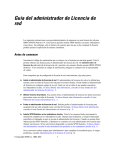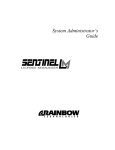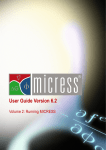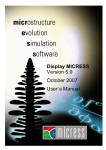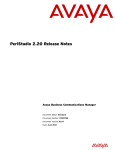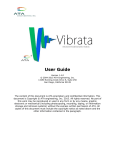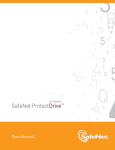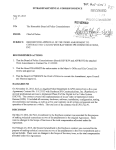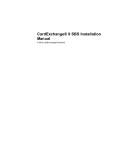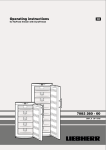Download Installing MICRESS - RWTH Aachen University
Transcript
User Guide Version 6.0 Volume I: Installing MICRESS 'Resolution of partial differential equations is more about art than science'. Apocryphal quotation from Numerical Recipes in Fortran “2+2=4 except for large values of 2” Anonymous “42” Douglas Adams edited 2011 by: Lilian Peters and Dr. Georg J. Schmitz Contents Contents .................................................................................................................. 3 1 Introduction ......................................................................................................... 1 2 What you should have got .................................................................................. 3 2.1. Procuring MICRESS® ............................................................................................. 3 2.2. The license files...................................................................................................... 5 2.3. Version variants...................................................................................................... 8 3 Setting up the license server ............................................................................. 11 3.1. Schematic Overview of the FLEXlm system ........................................................12 3.1.1 Setting up the FLEXlm license server under Windows ........................... 13 3.1.2 Starting the FLEXlm license service under Linux ................................... 23 3.1.3 Important security advice ....................................................................... 24 3.2 The Safenet Sentinel license server ......................................................................25 3.2.1 Starting the Safenet Sentinel license service under Windows ............... 25 3.2.2 Starting the Safenet Sentinel license service under Linux ..................... 26 4 Installing MICRESS on the clients ................................................................... 27 4.1. Introductory remarks ............................................................................................27 4.2. System requirements ............................................................................................27 4.3. Installing MICRESS® under Windows ..................................................................28 4.4. Installing MICRESS® under Linux........................................................................31 4.5. Hooking up the client to the License server ........................................................33 5. The MICRESS directories ............................................................................... 36 5.1. Introductory Remarks ...........................................................................................36 5.2. The MICRESS® binaries (BIN) directory ...............................................................37 5.3. The MICRESS® examples directory ......................................................................38 5.4. The License systems (FLEXlm and Safenet) .......................................................41 5.4.1. The FLEXlm license .............................................................................. 42 5.4.2. The SafeNet Sentinel license ................................................................ 43 5.4.3. Diagnostic Tools .................................................................................... 44 5.5. The MICRESS® Manuals directory ........................................................................46 6. Checking the installation ................................................................................ 47 6.1. Introduction ...........................................................................................................47 6.2. Viewing an existing result file with DP MICRESS ................................................49 6.3. Getting an existing simulation started under Windows .....................................51 6.4. Getting an existing simulation started under Linux............................................55 7. FAQ’s and trouble shooting ............................................................................ 58 Chapter 1 Introduction 1 Introduction The software MICRESS® (MICRostructure Evolution Simulation Software) is developed for time- and space-resolved numerical simulations of solidification, grain growth, recrystallisation or solid state transformations in metallic alloys. MICRESS® covers phase evolution, solutal and thermal diffusion and transformation strain in the solid state. It enables the calculation of microstructure formation in time and space by solving the free boundary problem of moving phase boundaries. The microstructure evolution is governed essentially by thermodynamic equilibria, diffusion and curvature. In case of multicomponent alloys, the required thermodynamic data can either be provided to MICRESS® in the form of locally linearized phase diagrams, or by direct coupling to thermodynamic data sets via a special TQ interface, developed in collaboration with Thermo-Calc™ AB, Stockholm. MICRESS® is based on the multi-phase-field method which defines a phase-field parameter for each of the phases involved. The phase-field parameter describes the fraction of each phase as a continuous function of space and time. Each single grain is mapped to a distinct phase-field parameter as well and is treated as an individual object in the microstructure. A set of coupled partial differential equations results, which describes the evolution of the phase-field parameter along with concentration, temperature, stress and flow fields. The total set of equations is solved explicitly by the finite difference method on a cubic grid. 2D and 3D simulations are possible. The size of the simulation domain, the number of grains, phases and components is restricted mainly by the available memory size and the CPU speed. Your suggestions or comments for improvements of the manual are highly welcome via email to [email protected]. MICRESS® User Guide Volume I: Installing MICRESS 1 / 53 Chapter 1 Introduction MICRESS® handles: 1-, 2- and 3-dimensional calculation domains arbitrary number of components, phases and grains solid-solid and solid-liquid interactions anisotropy of grain boundaries, mobility and energy MICRESS® supports: coupling to thermodynamic database (via the TQ-interface of Thermo-Calc™) The present MICRESS® User Guide Volume 1: MICRESS Installation comprises: an overview of the different options when purchasing MICRESS a step-by-step explanation of installing the software for Windows and Linux a description how to set up the license server a short description how to verify a successful installation MICRESS® User Guide Volume 0: MICRESS Phenomenology provides a description of the phase-field phenomenology and more details about the theoretical background of MICRESS. MICRESS® User Guide Volume 2: Running MICRESS provides a targeted and user- oriented description of the data pre-processing for the simulations and a detailed review of specific MICRESS features . MICRESS® User Guide Volume 3: Post-processing explains several possibilities for analysing, converting and documenting MICRESS results. MICRESS® User Guide Volume 4: Examples contains a collection of examples for simulations performed on various topics. MICRESS® User Guide Volume I: Installing MICRESS 2 / 53 Chapter 2 What you should have got 2 What you should have got 2.1. Procuring MICRESS® After having placed an order for MICRESS® and signing the MICRESS® End User License agreement following items should have been sent to you by Access or one of its agents: - the software package (either as a CD or by download) - one or two license files (two in case of the TQ coupled versions MICRESS “research TQ” and MICRESS “professional”) The present chapter“What you should have got”details the two delivery options for MICRESS®. Furthermore, general information about the license file – including an exemplary picture of the license file explaining the meaning of its several elements, like Host-IDs, licensed feature and the licensed version or the license expiry date – will be given. The first option of receiving MICRESS® is getting a CD of the software by mail, Fig. 2.1. : Figure 2. 1. Physical shipment of a CD comprising ® MICRESS . MICRESS® User Guide Volume I: Installing MICRESS 3 / 53 Chapter 2 What you should have got MICRESS® can also be downloaded from an ftp site as an ISO image of the CD. Both, CD and ISO image have identical content. The downloaded *.iso file should be opened using a CD/ DVD burning software and then be burned to CD. Downloading the ISO image: a) Use your usual browser and enter the following ftp- address: ftp://[email protected] ( not preceded by any“www.”) b.) A prompt window will appear asking for the password. This password will be provided by e-mail by Access or by one of its authorized agents. c.) Open the folder ‘MICRESS_RELEASES‘. In this folder you will find subfolders for a couple of the latest releases. In the folder with the highest version number you will find the *.iso images of the latest MICRESS® version. The subfolders starting with “Binaries” contain unarchived files available on the latest *.iso image (presently version 6.001). It is not necessary to install the Thermo-Calc software TQ interface separately when having procured MICRESS® with TQ interface. This procedure is executed by default. MICRESS® User Guide Volume I: Installing MICRESS 4 / 53 Chapter 2 What you should have got 2.2. The license files MICRESS® typically is installed in a network consisting of a license server and clients in a number of IP domains. The license server provides the link between the client and its license file. Chapter 3 “Setting up the license server” will provide detailed instructions about setting up and running the license server. There are two different license files. Depending on the actual installation either one or both are required a) A license type requiring only one license file. This holds for MICRESS® versions without coupling to thermodynamic data via the TQ interface i.e. MICRESS® “Research” and MICRESS® “Education” b) A license type requiring two license files. This holds for MICRESS® versions with coupling to thermodynamic data via the TQ interface i.e. MICRESS® “Research-TQ” and MICRESS® “Professional” Both types of license files will be provided by Access or by one of its authorized agents. Typical license files are shown in Figs. 2.2 and 2.3. : Figure 2. 2. Illustration of a license file with the vendor ACMICRES (i.e Access e.V., Aachen, Germany) The arrows indicate the specific meaning of a term or of a numerical expression. MICRESS® User Guide Volume I: Installing MICRESS 5 / 53 Chapter 2 What you should have got The license files contain information about: Name and Host-ID of the license server (see chapter 3) Information about the vendor (see chapter 3) The licensed feature details the different options being licensed. Typical features are “MICRESS” for the non-TQ coupled version, “MICRESS_EDU” for the restricted educational version, “MICRESS_TQ” for the TQ-coupled versions and “MICRESS_Stress” in case the elastic module is included The licensed version describes the actual version the client may use. All versions with version IDs smaller than the indicated version may be run using this license file. The given example allows to run any MICRESS version elder than version 5.4. The license expiry date indicates the duration of the license. In general even permanent licenses are automatically renewed annually and thus have an expiry date, unless the customer explicitly requests a “never” for this expiry date. The number of leases shows how many MICRESS jobs can be run simultaneously in the given network. Each job being started in the network receives a lease –or token- from the license server unless the number of leases is not exceeded. The IP domain(s). The IP number of the client plays a role when getting a license token from the license server. The IP number of the client has to be in the range being specified in the license file The licensed operating system options are Linux or Windows. In newer MICRESS releases Windows and LINUX are both licensed automatically. This option is thus omitted in more recent license files The Host-ID of a specific client. Each client has a certain ethernet address. In special cases, the license file may allow for a lease to a specific client (characterized by its Host-ID) even if it has no IP in the specified range of IPaddresses. MICRESS® User Guide Volume I: Installing MICRESS 6 / 53 Chapter 2 What you should have got Figure 2.3 is a license file example for a Thermo-Calc TQ – MICRESS installation, also with FLEXlm. Starting with MICRESS® version 6.0 and its new TQ interface, Thermo-Calc Software uses another license server system which is called Safenet Sentinel (see license file example in Figure 2.4.). Figure 2. 3. Example of a license file with the same network configuration as Figure 2.2. except of another vendor: “thermo_c” i.e. Thermo-Calc Software AB, Stockholm.The licensed feature is the TQ interface Figure 2. 4. License file with the same configuration as Figure 2.3. but for the Safenet License system MICRESS® User Guide Volume I: Installing MICRESS 7 / 53 Chapter 2 What you should have got To enable Access to issue a license file some information about the license server and the network of the clients is required. In detail this information comprises: name of the license server operating system of the license server IP-Address of the license server Host-ID of the license server IP domains of the clients (up to six domains of type 111.222.333.*) In general this information has been requested by Access or one of its agents well before and if you already have the license file, you can start to set up the license server as described in the following chapter. Please note/check, that the license server must have an IP within domains being specified for the clients. 2.3. Systems requirements /version variants For the MICRESS® Release Version 6.0 the following platforms are supported Windows XP / Windows 7 SUSE Linux Enterprise, resp. OpenSUSE ( Version 10.0 and newer ) recent RedHat distributions The Release 6.001 includes MICRESS® 32 and 64 bit versions. A GNU Compiler Suite 4.4 as a standard is necessary on all Linux systems. As suitable hardware configuration for MICRESS® simulations we recommend either a PC (for starters), preferably with two Intel quad-core CPUs of the current series, and min. 4GB RAM (8GB more) or a workstation. After setting the parameters "real" MICRESS simulations may take a few days and even more. Be aware that this computer is busy during that time and that the hardware is sufficiently reliable to operate continuously for MICRESS® User Guide Volume I: Installing MICRESS 8 / 53 Chapter 2 What you should have got days. In particular it should be noted that MICRESS® runs only on x86 compatible processors, i.e. standard Intel or AMD processors and not on exotics such as PowerPC, Itanium or others. Generally speaking, the faster the CPU, the better. At present current Intel CPU's are in front. A workstation or a computer as a dedicated server node may be a good choice in view of often being slightly faster at the same CPU clock rate because having a faster memory interface. Plenty of memory (4GB minimum, preferably more) is strongly recommended. MICRESS, especially for 3D simulations, needs much memory. Running multiple jobs simultaneously in typical parametric study applications thus requires the use of a 64bit version of the operating system being provided along with the present release. The MICRESS capabilities are the same for both operating systems and the respective executables all are in “double precision”. In the following the version variants for Version 6.0 are presented - including their disadvantages and advantages when deciding in favor of one of them. I. MICRESS TQS x64 (micress.exe) This will be the standard version and the basis for all future developments Pros: 64 bit operations, larger address space, future standard Cons: requires a 64 Bit operating system requires ges_files being created with Thermo-Calc’s newest version TCC-S, old ges5_files built with Thermo-Calc Versions R and earlier cannot be run. Recommendation: If you have a 64 Bit operating system and the newest version of TCC-S, you should use this version. II. MICRESS TQS x32 Pros: allows use of TQS features in a 32 bit environment. MICRESS® User Guide Volume I: Installing MICRESS 9 / 53 Chapter 2 What you should have got Cons: Requires ges_files being created with Thermo-Calc’s newest version TCC-S, so old ges_files cannot be run. Recommendation: If you have a 32 Bit operating system and the newest version of TCC-S, you should use this version. III. MICRESS TQR_x32 Pros: This version can be used along with your old ges_files Cons: in the long term TQ-R will not be supported, some features available in TQ-S cannot be used Recommendation: If you do not want to upgrade your Thermo-Calc Software, you have to use this version. This version will however not be further supported in the midterm. The next scheduled release (Version 6.1) will not continue support of TQ-R coupling version. MICRESS® User Guide Volume I: Installing MICRESS 10 / 53 Chapter 3 setting up the license server 3 Setting up the license server “Setting up the license server”provides hints to the configuration of the license server allowing to install and to run MICRESS® on the client computers in the network being specified in the license file. This operation in general is performed by the system administrators and not by the MICRESS users. To set up the license server it is recommended to install MICRESS® also on the license server. This procedure is similar to the installation on the individual clients, please refer to chapter 4“Installing MICRESS on the clients”. The MICRESS® license is based on the FLEXlm system and all details about this licensing system can be found in the FLEXNet licensing end user guide (see chapter 5:“The MICRESS directories). Starting with MICRESS version 6.0, Thermo-Calc software makes use of another license server: Safenet Sentinel. The installation of this license service is also explained in this chapter. The present chapter thus is meant as a quick-start reference describing the basic steps to be taken to set-up the license server. After a schematic overview of the FLEXlm license system, fig 3.1, a short description the graphical front-end of the FLEXlm system, the lmtools.exe, is given followed by details of the individual steps to be taken for installing the license server under Windows. The installation of the FLEXlm system with Linux/Unix will be introduced as well. Furthermore, the installation procedure of the Safenet Sentinel license system for both Windows and Linux/Unix will be detailed. Successful installation on server and/or clients can be verified using some examples as detailed in chapter 6. MICRESS® User Guide Volume I: Installing MICRESS 11 / 53 Chapter 3 setting up the license server 3.1. Schematic Overview of the FLEXlm system Client A 817648761e8d 111.222.333.23 Client B 0006a3761e5b 111.222.333.45 Client C 729h364a6354 111.222.333.57 Client D 0004760f1a1c 111.222.444.36 Client E Client F Server “Servername” IP … license files: 111.222.333.x ; 111.222.334.x (e.g. max. 10 leases) running vendor demon(s): acmicres and/or thermo_c bc237945ad1f Client 111.222.334.11 D 327aa19be363 111.222.334.12 Client X Host-ID IP-domain The license server with name“Servername” runs the vendor demons acmicres and thermo_c and monitors the active number of MICRESS job leases. Client B runs four jobs, which can be performed because its IP number fits to the IP range specified in the license file. Client D does not get a lease because the license server monitors it as an invalid client with an IP address outside the IP range specified in the license file. In case the max. number of leases is exceeded the server does not dispense any further lease – even if a client has a valid IP address. This client has to wait until a lease is returned from another client. Client F thus does not get a lease. Special case: If the actual Host-ID of a client is explicitly included in the license file, its IP number may be outside the IP-range specified in the license file. MICRESS® User Guide Volume I: Installing MICRESS 12 / 53 Chapter 3 setting up the license server 3.1.1 Setting up the FLEXlm license server under Windows The first step of setting up the license server is to locate the license system directory and the graphics- front end ”lmtools.exe”, fig. 3.2: Figure 3. 2. lmtools –your key to the license server manager. The individual files in the FLEXlm directory are itemized below: - lmtools.exe is a graphical user interface to the license server manager. It performs functions like starting, stopping and configuring FLEXnet license server systems or getting information like the Host-ID. - ACMICRES.exe is the vendor demon for the MICRESS license file. A further demon is called thermo_c.exe and has to be run for the TQ part of the MICRESS® license file. So when using MICRESS with TQ coupling two vendor demons have to be run. The vendor demon, the license server manager (lmgrd) and the two/one license files form the entire software of the license server system. - thermo_c.exe is the vendor demon of Thermo-Calc which has to be run for the TQ part of the MICRESS® research TQ and MICRESS professional installations. So when using MICRESS with TQ coupling two license services have to be set-up. The vendor demon(s), the license server manager (lmgrd) and the two/one license files MICRESS® User Guide Volume I: Installing MICRESS 13 / 53 Chapter 3 setting up the license server form the entire software of the license server system. As in general Thermo-Calc installations are already available at sites where MICRESS shall be installed, the thermo_c.exe file should already be available. Please contact ACCESS or one of its agents in case you should need a copy of the thermo_c.exe executable. - Get_Host_ID is the tool needed to retrieve the Host-ID. - Host_ID_name. In this ‘.txt’document the Host-ID is saved by the “Get_Host_ID”. - lmdiag , the diagnostic tool, lists each license lease and serves for debug purposes. It may display problems or identify successful license checks. - lmgrd is the license server manager. The license server manager and the vendor demon add up to the entire license server system that provides the license leases. After double clicking on lmtools.exe, the lmtools window will appear, fig 3.3. To continue, hit the tab “Config Services” leading to fig 3.4. Figure 3. 3. The basic task bar of lmtools MICRESS® User Guide Volume I: Installing MICRESS 14 / 53 Chapter 3 setting up the license server After specifying the service name (acmicres or thermo_c) enter correct paths to lmgrd.exe, to the license file and to the log file. Figure 3.4. In the “Config Services” menu several paths have to be set: Service Name: specify the name of the service here (e.g. acmicres). For multiple vendors please specify one service per vendor resp. one service per license file Path to the lmgrd.exe file: enter the correct path to the lmgrd.exe being located in the FLEXlm directory (see Figure 3.3.) Path to the license file: enter the path to the license file Path to the debug log file: enter the path to the debug log file. The respective file will be created during runtime. To specify different file locations, make sure that a fully qualified path is specified. Once the paths are set please click on “use services” and optional “Start Server at power up” and then‘Save Service’. Switch to the ‘Start/Stop/Reread‘ tab, pick the service you have just saved and start it. For verification it is useful to click on the‘Server Diags’and to check if the server works correctly, see figs. 3.5, 3.9 and 3.10 MICRESS® User Guide Volume I: Installing MICRESS 15 / 53 Chapter 3 setting up the license server Figure 3. 5. The Installation of the license server has been successful. Further tabs in the lmtools task bar are: “Service/ License File”, “System Settings”, “Utilities”, “Start/ Stop/Reread”, “Server status”, “Server Diags”, “Config Services” and “Borrowing”. These functionalities are helpful when installing and operating the license server and their basic use is elaborated in the following. For a more detailed explanation of these functionalities please refer to the FLEXNet licensing end user guide. MICRESS® User Guide Volume I: Installing MICRESS 16 / 53 Chapter 3 setting up the license server - Service / License File Figure 3. 6. The ‘Service/ License File’ button of the lmtools menu. “Configuration using License File” is meant for node locked installations only. MICRESS in general is installed in a network and a “Configuration using Services” thus is to be used. - System Settings displays HOST-ID and a number of other settings of the computer settings, which can’t be changed. By clicking on the ‘Save Host-ID into a file’ button, a new document (by default in the in the FLEXlm directory) will be created. It contains the Host-ID information - which then is available e.g. for issuing the license file. Figure 3.7. The created text file for the HOST-ID. MICRESS® User Guide Volume I: Installing MICRESS 17 / 53 Chapter 3 setting up the license server - Utilities: the utilities menu, fig 3.8, provides a valuable tool for both the license server and also for hooking the clients to the license server. Figure 3.8 The vendor path operations‚Utilities ’ First “list all vendor paths” to see if the vendors “thermo_c” and “acmicres” are already known to the computer. In case of “yes” and the listed vendor paths being correct, MICRESS should perform normally on this computer. In case the vendor paths are not specified correctly, you may add a vendor path by entering the vendor name “acmicres” and by specifying the path to the license server “@servername” and the clicking on “Add Vendor Path”. In case of numerous paths being indicated, it is recommended using “Override Path” as old paths may point to elder licenses not specifying all the features of a new license, which may lead to problems for the newer features. This is also the way to create the link between the clients and the license server. - Start/Stop/Reread activates or deactivates the license manager on the license server. It is possible to re-read the license file. - Server status counts the number of licensing activities and shows if the vendor demon is running. The server name in this example is “sf1”. Figure 3.9 reflects the MICRESS® User Guide Volume I: Installing MICRESS 18 / 53 Chapter 3 setting up the license server current server status for the individual demons. Similar diagnostics can be performed for the different features (see e.g. in your license file) like “MICRESS”, “MICRESS_EDU” (educational version), “MICRESS_TQ” ( TQ-coupled versions) and “MICRESS_Stress” in case the elastic module is included. Figure 3.9. Checking the Server status for the vendor daemons acmicres (top) or thermo_c (below) - Server Diags ( = Diagnostics) allows to check whether a certain feature is licensed or the server works. Typical features of MICRESS are “MICRESS”, “MICRESS_EDU” MICRESS® User Guide Volume I: Installing MICRESS 19 / 53 Chapter 3 setting up the license server (educational version), “MICRESS_TQ” in combination with TC-TQ (for TQ-coupled versions) and “MICRESS_Stress” in case the elastic module is included. The different paths to various license files (see also “utilities” menu in fig 3.8) are scanned for valid licenses for this particular feature. Availability of a valid license for the feature may thus be checked. All input is case sensitive. A typical output is shown in fig 3.10 Figure 3.10. Perform diagnostics to find the correct server/license for a specific feature - Config Services (= Configuration Services) asks for inserting the paths to the listed files. The Service name stands for the vendor demon. The function ‘View log’ is quite MICRESS® User Guide Volume I: Installing MICRESS 20 / 53 Chapter 3 setting up the license server important for administrators managing the server because it lists all enquiries to the server, Fig. 3.11. 16:15:48 (lmgrd) Please Note: This log is intended for debug purposes only. In order to capture accurate license usage data into an organized repository, please enable report logging. Use Macrovision's software license administration solution, FLEXnet Manager, to readily gain visibility into license usage data and to create insightful reports on critical information like license availability and usage. FLEXnet Manager can be fully automated to run these reports on schedule and can be used to track license servers and usage across a heterogeneous network of servers including Windows NT, Linux and UNIX. Contact Macrovision at www.macrovision.com for more details on how to obtain an evaluation copy of FLEXnet Manager for your enterprise. FLEXnet Licensing (v10.8.0.1 build 19446) started on SF1 (linux) (5/7/2010) Copyright (c) 1988-2005 Macrovision Europe Ltd. and/or Macrovision Corporation. All Rights Reserved.US Patents 5,390,297 and 5,671,412. World Wide Web: www.macrovision.com License file(s): network/programs/linux/MICRESS/license/MICRESS_License.lic lmgrd tcp-port 27003 16:15:48 (lmgrd) Starting vendor daemons ... 16:15:48 (lmgrd) Using vendor daemon port 27010 specified in license file 16:15:48 (lmgrd) Started ACMICRES (internet tcp_port 27010 pid 30107) 16:15:48 (ACMICRES) FLEXnet Licensing version v11.7.0.0 build 73797 i86_lsb 16:15:48 (ACMICRES) lmgrd version 10.8, ACMICRES version 11.7 16:15:48 (ACMICRES) Server started on SF1 for: MICRESS_TQ 16:15:48 (ACMICRES) MICRESS_Stress, MICRESS_Flow, MICRESS_Parallel 16:15:48 (ACMICRES) EXTERNAL FILTERS are OFF 16:15:48 (lmgrd) ACMICRES using TCP-port 27010 16:32:35 (ACMICRES) TCP_NODELAY NOT enabled 17:25:11 (ACMICRES) OUT: "MICRESS_Stress" [email protected] 17:25:11 (ACMICRES) OUT: "MICRESS_TQ" [email protected] 17:25:21 (ACMICRES) IN: "MICRESS_Stress" [email protected] 17:25:21 (ACMICRES) IN: "MICRESS_TQ" [email protected] ….… Figure 3.11. Example of a section of a log file This log file lists all the activities of a vendor demon (here ‘acmicres’) like giving a lease for a certain feature to a client or user, or reacquiring the respective feature. Leasing a feature to a client can be identified by the term ‘OUT’ and the return of the lease to the vendor demon is indicated by ‘IN’ always followed by the name of the user at the respective client. This information is collected over a long period of time, thus just a generic extract is presented here. MICRESS® User Guide Volume I: Installing MICRESS 21 / 53 Chapter 3 setting up the license server - Borrowing refers to the maximum duration of a lease and some other options to manage the distribution of licenses in a network via a defined lease time. For detailed information on this option please refer to the FLEXNet licensing end user guide. At the end of this section on “Setting up the license Server” your license server manager should be operational and it should be possible to run MICRESS directly on the license server at least without TQ coupling (using e.g. the Grain_Growth.dri, see chapter 6). This is the first check you should make in terms of potential trouble shooting. Running MICRESS successfully on the license server indicates the license file and the lmgrd configurations to be correct. The next step is to install the Safenet license system for the TQ part (see 3.2.1) and eventually to install MICRESS on the individual clients as described in section 4. MICRESS® User Guide Volume I: Installing MICRESS 22 / 53 Chapter 3 setting up the license server 3.1.2 Starting the FLEXlm license service under Linux After the installation of MICRESS, you will find the FLEXlm license manager demon ‘lmgrd’ in the ‘FLEXlm’ subdirectory. Usually it is sufficient to start it on your designated license server machine with the following options: lmgrd -2 –p –c <license file> -l <log file> Where the ‘license file’ is the file which you receive from the vendor and the ‘log file’ is a new file to store the demons log messages. The license manager itself will start a second process for the vendor demon ‘ACMICRES’, resp. ‘thermo_c’. For communication between the server and the clients a TCP/IP connection will be enabled using ports in the range from 27000 to 27010 by default or as defined in the license files. Please make sure that the firewall will not block these ports. For security reasons, the use of the default port 27000 is not recommended. The port number may be added by the end-user to the server line in the license file: SERVER servername host-id [port-number] A valid port-number is any unused port number between 0 and 64000. On UNIX, choose a port >1024, since those <1024 are privileged port numbers. The port number is optional if lmgrd, the vendor daemon, and the application are higher than v6+. If no port number is specified, one of the default ports in the range of 27000 and 27010 will be used. Flexera Software moreover recommends starting the license server demon with non root privileges. The FlexLM utility ‘lmutil’ is a general purpose tool to stop and run diagnostics on the license manager. lmutil lmdown – end the license manager demon process. Alternatively, the entire lmgrd process may be finished by “kill <process id>” lmutil lmdiag – perform diagnostics See the ‘FLEXNet licensing end user guide’ for more information. MICRESS® User Guide Volume I: Installing MICRESS 23 / 53 Chapter 3 setting up the license server 3.1.3 Important security advice Flexera Software notified customers of a possible security vulnerability reported in the FlexNet Publisher lmgrd license server managers as well as vendor daemons in August 2011. More specifically, it is possible that a malicious user with full access to the internal network could remotely execute arbitrary code under the user context. Flexera Software has delivered a hotfix for the FlexNet Publisher v11.10 lmgrd and vendor daemon releases as a precautionary measure. For the MICRESS Version 6.0 distribution, these hotfixes have already been incorporated in a new vendor demon and lmgrd license server manager. Customers of elder versions were notified by e-mail. This hotfix does not alleviate the need to run lmgrd and vendor daemons in a least privileged security context. Thus, in addition, the following best practices are recommended by Flexera Software: The following steps are recommended as License Administrator best practices to help protect against potential security vulnerabilities (see also respective file in the FlexLM directory of your MICRESS installation for further information): Limit access to administrative users only by running the license server manager in a restrictive mode. The ‘-2 –p’ command-line option on lmgrd is the recommended setting. Refer to the product documentation for limitations related to usage of these command-line options. Do not use the default 27000 TCP port. Utilize the recommended security settings offered by the Operating System (OS) vendors that resist the buffer/stack overflow attacks. For example, the Data Execution Prevention (DEP) feature on Windows helps in this regard. Most OS updates also include security features that take advantage of both hardware and software based protection mechanisms against malicious code execution. MICRESS® User Guide Volume I: Installing MICRESS 24 / 53 Chapter 3 setting up the license server 3.2 The Safenet Sentinel license server From MICRESS version 6.0 and later, the TQ interface of Thermo-Calc is licensed via a new license system, the Safenet Sentinel. The basic concept of the Safenet Sentinel license server is quite similar to the FLEXlm system. The installation wizard from Safenet is presented in Figure 3.12. Figure 3.12 The Thermo-Calc Software makes use of another License Manager which is called Safenet Sentinel. This change applies to MICRESS version 6.0 and later. 3.2.1 Starting the Safenet Sentinel license service under Windows The installation files for the network license manager are found in the folder Safenet in your MICRESS installation directory. Copy these to the computer where the license manager will be installed and double-click the file “Setup.exe”. Follow the instructions during the installation and choose the default installation folder. The license manager will be installed to “C:\Program Files\Common Files\SafeNet Sentinel\Sentinel RMS License Manager\WinNT”, or similar. Open the folder “Licenses\Floating” on the CD and copy the license file “LSERVRC” to the folder where the license manager was installed (…\WinNT). Try to start MICRESS with a TQ coupled example e.g. Delta-Gamma on the server. If it doesn’t work, restart the computer. If the license server is running on the same subnet as the client, it will normally be detected automatically. However, if the server is on a different subnet, there is a need to explicitly MICRESS® User Guide Volume I: Installing MICRESS 25 / 53 Chapter 3 setting up the license server define on the client where the server resides. This is done by accessing the "Advanced" tab of the "System Properties" in the "Control panel". There by clicking the "Environment Variables" button, a variable named "LSHOST" may be entered containing the name/address of the license server. 3.2.2 Starting the Safenet Sentinel license service under Linux The Safenet license service must be run with root privileges. Use the script file ‘restart_lserv’ to start the license service demon on your designated server. Before running the script, edit the script file in the following way. BINDIR should be the correct path to the license manager (lserv) and LICENSE_FILE the path to lservrc (the license file). LOGDIR is the path to where the log files are stored. The MICRESS/bin/safenet directory (in a standard linux installation) contains the following files: - echoid program file used by gethostid - gethostid script that outputs the computer ID needed for a license file onto a text file - lserv program file that runs a license service - lsmon program file for monitoring the license service - lsrvdown program file for stopping the license service - lswhere program file for locating license servers - restart_lserv template for a script for restarting the license service The license server setup consists of two parts: lserv which is the license server manager (or demon), and lservrc, which is the license file. The correct license file for your system is either included on the distribution CD in the licenses folder, or has been sent to you by e-mail. If you do not have a license file, contact Access or your local agent. It is recommended to copy the server license file to the “MICRESS/bin/Safenet” directory. MICRESS® User Guide Volume I: Installing MICRESS 26 / 53 Chapter 4 Installing MICRESS on the clients 4 Installing MICRESS on the clients This chapter will detail the procedure for installing MICRESS under both Windows and Linux on your client computer. 4.1. Introductory remarks Installing MICRESS should be done with its installer. In case of using Windows, it is necessary to have ‘power user’ privileges in view of necessary rights to modify the registry to set file associations during installation. Make sure your client works within one of the domains specified in the license file and can communicate with the license server. 4.2. System requirements The operation of the current version of MICRESS® is approved for the following minimum system configuration: • Windows (XP or higher) or Linux (kernel version 2.2 or higher) • Processor: Intel Pentium III (or equivalent) and 512 MB main memory, the more the better • Graphic card • min. 100 MB HD- storage MICRESS® User Guide Volume I: Installing MICRESS 27 / 53 Chapter 4 Installing MICRESS on the clients 4.3. Installing MICRESS® under Windows In order to install MICRESS on your computer, please insert CD into CD-ROM Drive. The installation will start automatically: Figure 4. 1. The window pops up asking to carry the installation into execution. In general, MICRESS installation should start automatically; else it is possible to run the INSTALL_MICRESS.exe manually. MICRESS® User Guide Volume I: Installing MICRESS 28 / 53 Chapter 4 Installing MICRESS on the clients Figure 4. 2. Entering the data in order to perform the installation During the installation process, please make the following decisions: Select an installation type. There are the two options to install the software (a) with or (b) without demo results. Copying the demo results is recommended if sufficient disc space is available. “Installation directory” defines the directory where MICRESS will be installed on your computer. Your favoured directory may be selected by clicking on the file symbol. Linux or Windows platforms (32 or 64 bit) may be selected as the operating system. Please read the license conditions carefully by scrolling down and then tick the respective box to accept the license conditions. MICRESS® will then be installed on your computer by clicking the ‘Install MICRESS’– button. MICRESS® User Guide Volume I: Installing MICRESS 29 / 53 Chapter 4 Installing MICRESS on the clients The end of the installation is indicated by a respective window, fig 4.3. Figure 4.3. ® MICRESS has been successfully installed on your computer if this window appears. MICRESS® User Guide Volume I: Installing MICRESS 30 / 53 Chapter 4 Installing MICRESS on the clients 4.4. Installing MICRESS® under Linux The Linux installation is similar to the installation under Windows. Insert the CD into CD-ROM drive. The installation will start automatically when clicking‘Run’. If the installation window does not pop up automatically, start the ‘Install_MICRESS_Linux’ program in the disk root directory manually. Figure 4. 4. The window pops up asking you to run the installation. Figure 4. 5. Entering the data in order to perform the user defined installation in case of accepting the license conditions. MICRESS® User Guide Volume I: Installing MICRESS 31 / 53 Chapter 4 Installing MICRESS on the clients During the installation process, please make the following decisions: Select an installation type. There are the two options to install the software (a) with or (b) without demo results. Copying the demo results is recommended if sufficient disc space is available. “Installation directory” defines the directory where MICRESS will be installed on your computer. Your favoured directory may be selected by clicking on the file symbol. Linux or Windows platforms (32 or 64 bit) may be selected as the operating system. Please read the license conditions carefully by scrolling down and then tick the respective box to accept the license conditions. MICRESS® will be installed on your computer by clicking the ‘Install MICRESS’– button. The program will give you response in case of a succesful installation process. Then you will find MICRESS® on you computer. Figure 4.6. In the event of a not automatically opening installation window there is a backup option. MICRESS® User Guide Volume I: Installing MICRESS 32 / 53 Chapter 4 Installing MICRESS on the clients 4.5. Hooking up the client to the License server Hooking the MICRESS client to the license server in general should proceed automatically when starting MICRESS the first time on the client. Start MICRESS by “drag and drop” of a MICRESS® driving file (e.g. the delta-gamma.dri from the examples) onto the MICRESS® executable. A command prompt console, as shown in Figure 4.7, should show up asking for the specification of a license. There are two options: a) either enter the name of the license server (here “servername”) as “@servername” followed by return or b) (for node-locked installations only!) pressing “return” twice and select the license file, as shown in Figure 4.8. This procedure is only necessary for the first start up of MICRESS® or if the location of the license file is altered. The entered locations will be stored in the windows registry for future use (power user privileges necessary). For MICRESS TQ-installations (either drawing on Safenet or FLEXlm license services) a similar question for a further license file will appear the first time a TQ-relevant routine is called by MICRESS®. Proceed as above and re-enter the servername also for the second license. Alternatively, it is possible to set following user profile environment variables to provide the license location information for the client: ACMICRES_LICENSE_FILE=@servername - for the MICRESS license THERMO_C_LICENSE_FILE=@servername - in case of using a Thermo-Calc library version R (default up to MICRESS_TQ version 5.5) LSHOST=servername – in case of using a Thermo-Calc library version S (default in MICRESS_TQ version 6.0). This is possible without power user privileges and no changes of the registry are necessary. The same variable names are also used for licensing with a Linux operating system. MICRESS® User Guide Volume I: Installing MICRESS 33 / 53 Chapter 4 Installing MICRESS on the clients Figure 4.7. The software cannot find the appropriate license file. This is the default situation during the first ramp-up. Please specify the license server (see text) Figure 4.8. Specifying the location of the license file for a node locked installation. MICRESS® User Guide Volume I: Installing MICRESS 34 / 53 Chapter 4 Installing MICRESS on the clients In case this automatic hooking or the specification of the environment variables should not allow to connect with the license server for whatever reason, following procedure is recommended (see also Fig. 3.4 in section 3.1.1): Run the LMtools.exe (see FlexLM directory) on the client. Select “utilities” and enter “acmicres” as a vendor name and “@servername” (where servername is the name of your license server) in the respective boxes. Then click “Add Vendor Path”. Proceed the same way for the thermo_c demon (used along with MICRESS up to version 5.5) by entering “thermo_c” as vendor name and “@servername” for the path. Eventually check “list all vendor paths” and make sure that a path to your license server is set for each of the two demons acmicres and thermo_c. As a final verification you may check the “server status” on the client by entering “@servername” and perform a status enquiry. If words like “Vendor daemon status (on servername): ACMICRES: UP v11.10” and “Vendor daemon status (on servername): thermo_c: UP v9.2” appear in the diagnostics report, the client is successfully hooked to the server In case a connection to the license server can still not be established, the problem is most probably related to the firewall settings on the server. FLEXlm by default needs the following ports to be open: 2080 and 27000 through 270010. However, there is a security recommendation to specify another port (see 3.1.3). Please configure your firewall accordingly to have the specified port open and retry the server diagnostics on the client. MICRESS® User Guide Volume I: Installing MICRESS 35 / 53 Chapter 5 The MICRESS directories 5. The MICRESS directories 5.1. Introductory Remarks This chapter highlights the structure of the program and the functional use of the different menu items. After installation of MICRESS®, which is located in the directory you specified during the installation procedure, the MICRESS® subdirectories should be present, fig. 5.1. In the following sections these four MICRESS® subdirectories will be shortly addressed to facilitate orientation/navigation and to highlight their purpose. . Figure 5. 1. In the installation directory you should be able to identify these five subdirectories. The Bin directory contains the MICRESS® executables, the Examples directory comprises MICRESS® examples, the FLEXlm and Safenet directories include MICRESS® licensing tools and license files, the Manuals directory provides the different MICRESS® manuals. These components are explained in detail in the following. MICRESS® User Guide Volume I: Installing MICRESS 36 / 53 Chapter 5 The MICRESS directories 5.2. The MICRESS® binaries (BIN) directory Here the MICRESS® binaries and their related files are located: Figure 5. 2. The Bin directory contains executable files and some program libraries Shortcuts to the batch files “Start_MICRESS”, “Start_MICRESS_noTQ” and the binary “DP_MICRESS” will be created on all users desktop during installation. TQ-coupled versions can also run simulations not using the TQ interface, but not the other way round. MICRESS® User Guide Volume I: Installing MICRESS 37 / 53 Chapter 5 The MICRESS directories 5.3. The MICRESS® examples directory The MICRESS examples directory comprises subdirectories for the .ges files (thermodynamic data) being needed to run the TQ coupled examples and subdirectories containing the results of the different examples fig.5.3, a number of special text files for specific examples, fig 5.4, and the driving files needed to run the examples, fig 5.5. Figure 5. 3. and Figure 5. 4. (see Figure 5.4. on the next page) MICRESS® User Guide Volume I: Installing MICRESS 38 / 53 Chapter 5 The MICRESS directories MICRESS® User Guide Volume I: Installing MICRESS 39 / 53 Chapter 5 The MICRESS directories The examples directory contains different driving – and/or result files allowing to run and to visualize several available simulations. To check the installation, run one of these examples and subsequently have a look at the result files by using DP_MICRESS. A detailed instruction of handling this procedure is explained in chapter 6 ‘Checking the installation’. MICRESS examples directory → Results Figure 5.6. The Delta_Gamma results also explain the generic meaning of the examples result files being found in the result directories of other examples MICRESS® User Guide Volume I: Installing MICRESS 40 / 53 Chapter 5 The MICRESS directories 5.4. The License systems (FLEXlm and Safenet) The License system contains several files related to the license and the license server. The directories FLEXlm and Safenet refer to the different license services used by MICRESS and by the TQ interface. MICRESS uses the FLEXlm license system, while the TQ part of the license depends on the actual version, see table. There are also some diagnostic tools available which simplify searching for errors or assist in trouble shooting. License MICRESS® without TQ MICRESS license Windows Linux FLEXlm FLEXlm FLEXlm FLEXlm FLEXlm FLEXlm FLEXlm FLEXlm Safenet Safenet (all versions) MICRESS® with TQ (up MICRESS license to version 5.5) MICRESS® with (from version 6.0) TQ license TQ MICRESS license TQ license MICRESS® User Guide Volume I: Installing MICRESS 41 / 53 Chapter 5 The MICRESS directories 5.4.1. The FLEXlm license Figure 5.7. The FLEXlm directory In detail these files are: - ACMICRES is the vendor daemon for the license file. The other one is called thermo_c. The vendor daemon plus the license server manager (lmgrd) result in the complete license server system. - Lmgrd is the license server manager. The license server manager and the vendor demon add up to the whole license server system that provides the license files. - Lmtools is a graphical user interface to the license server manager. It performs functions like starting, stopping and configuring FLEXnet license server systems or getting information like the Host-ID. MICRESS® User Guide Volume I: Installing MICRESS 42 / 53 Chapter 5 The MICRESS directories 5.4.2. The SafeNet Sentinel license The Safenet Sentinel license and its tools are quite similar to the FLEXlm license. For more please take a look at the website www.SafeNet-Inc.com/Sentinel. MICRESS® User Guide Volume I: Installing MICRESS 43 / 53 Chapter 5 The MICRESS directories 5.4.3. Diagnostic Tools The diagnostic tools MIC_Info.bat (for Windows) resp. MIC_Info.sh (for LINUX) are found in the root installation directory. The MIC_Info tool is a diagnostics tool which writes a “.txt” file when running it. This written file can give information about several problems you might have. Just send the file to your MICRESS contact and we can find solutions. The file MIC_info.txt will be saved in the directory “C:\micress” under Windows or in the directory where you start the script under Linux. - Get_Host_ID is the tool you need in order to receive the Host-ID. - Host_ID_name. In this ‘.txt’ document you can find the Host-ID after having tabbed on the ‘Get_Host_ID‘. - lmdiag lists each license itemized and debugs them. It may display problems or point a successful license check. - echoid is required for the MIC_Info tool. Figure 5. 8. Results of a check after using the MIC-info tool. MICRESS® User Guide Volume I: Installing MICRESS 44 / 53 Chapter 5 The MICRESS directories MICRESS® User Guide Volume I: Installing MICRESS 45 / 53 Chapter 5 The MICRESS directories 5.5. The MICRESS® Manuals directory Figure 5. 9. ® The ‘Manuals’ directory comprises the manuals for MICRESS and the License systems FLEXlm ® and Safenet being helpful when installing and using MICRESS . The FLEXNet licensing end user guide and the Safenet user manual comprise any detailed information relating to the license systems. The five MICRESS® manuals refer to the different applications of the software: MICRESS phenomenology, MICRESS Installation, Running MICRESS®, MICRESS Post-processing and MICRESS Examples. For questions not being answered in one of these manuals, please do not hesitate to contact Access or one of its agents. Another option of finding answers is to consult the MICRESS users forum under www.micress.de. MICRESS® User Guide Volume I: Installing MICRESS 46 / 53 Chapter 6 Checking the installation 6. Checking the installation 6.1. Introduction The chapter “Checking the installation”contains step by step instructions for running two simple examples. Scope of this exercise is to verify the successful installation of MICRESS on the client. The two examples being described in detail are “Grain Growth”as a typical example for a simulation without Thermo-Calc-coupling and “Delta_Gamma” which comprises coupling to thermodynamic data. The example with Thermo- Calc coupling is also important because it makes use of another license vendor (thermo_c) and even another license server (Safenet Sentinel) from version 6.0. First step is the visualization of an already existing example being provided with the distribution using DP_MICRESS. This will show how the results should look like after having started an own simulation later. The respective result will be overwritten by your own simulation. The first result to be visualized is the distribution of the individual grains in the grain-growth example. This example is located in the “MICRESS examples” directory in the subdirectory “Results_Grain_Growth”. There are a number of different result file types for this particular grain growth simulation. Please refer to the MICRESS manuals Volume 2 and Volume 3 for a detailed explanation. For checking the installation it is sufficient to use the following result file: Grain_Growth_korn.mcr (the extension .mcr may not always be displayed). There are several different options for visualizing this result file e.g: MICRESS® User Guide Volume I: Installing MICRESS 47 / 53 Chapter 6 Checking the installation the drag-and-drop option left- click the result file and hold the button pressed, then drag-and-drop the file onto the DP MICRESS shortcut icon. right- click on a result file and select ‘open with…‘ . selecting DP MICRESS from the list will then autostart the program. double-clicking on the result file The process of checking the installation consists of two separate steps: 1) First run DP MICRESS with an existing results file. In detail: Using the visualization tool to find out how your example should look like (before running it yourself). Use e.g. the result file “Grain_Growth_ korn.mcr”. The mere visualization of result files does not need any license. 2) Running an existing simulation setting ( a license is mandatory) by using a so-called “_dri” file, a) Grain_Growth_dri (without TQ- coupling) b) Delta_Gamma_dri (comprising TQ- coupling) MICRESS® User Guide Volume I: Installing MICRESS 48 / 53 Chapter 6 Checking the installation 6.2. Viewing an existing result file with DP MICRESS It is possible to check the output by taking a look at a result file. DP_MICRESS is used for this operation. An existing example file can be dragged and dropped on the display tool. Here the example of ‘Grain_Growth_korn.mcr’(without TQ-coupling) is used. Figure 6. 1. Dropping a result file onto DP_MICRESS The opening window should look like the following: Figure 6. 2. The window represents the result for the first time i.e. step, the initial conditions MICRESS® User Guide Volume I: Installing MICRESS 49 / 53 Chapter 6 Checking the installation Because DP_ MICRESS displays a completed simulation each individual time step may be viewed – even just in the first place. Figure 6.3 shows the last step of this simulation. You can directly switch from the first to the last time step or step through the time-steps by “next” or “previous”. A detailed description of DP_MICRESS is found in the MICRESS manual Vol. 3 on “MICRESS post processing” Figure 6.3. The last time step of the Grain_Growth_korn example MICRESS® User Guide Volume I: Installing MICRESS 50 / 53 Chapter 6 Checking the installation 6.3. Getting an existing simulation started under Windows MICRESS® simulations in general are run by a so called driving file. Examples for driving files are found in the examples directory. A MICRESS simulation is started by dragging-anddropping the file “Grain_Growth_dri” onto the MICRESS® shortcut. After first results are written into the results file (check date/time of file up-date), it is possible to have a direct look at them by using DP_MICRESS even while MICRESS is still continuing the simulation. The example of ‘Grain_Growth_dri’( without TQ-coupling) is presented again. Figure 6. 5. Running a simulation with a driving file by ‘dragging and dropping’ it on MICRESS® MICRESS® User Guide Volume I: Installing MICRESS 51 / 53 Chapter 6 Checking the installation Figure 6. 6. ® The MICRESS simulation is running and MICRESS® has created its first outputs indicating a successful installation It is helpful to take a look at the clicking time to check whether MICRESS® has started creating output – also during an ongoing simulation. It enables finding the most recent files in the ‘Results’directory. Figure 6. 7. New result files are created after starting a MICRESS simulation. Have a look at date and time of the last modification, of the files, which should roughly correspond to the actual time (lower right corner) for an ongoing simulation MICRESS® User Guide Volume I: Installing MICRESS 52 / 53 Chapter 6 Checking the installation Now it is possible to check the output by taking a look at the result file. DP_MICRESS is used for this operation. You can compare the results to those in Chapter 6.2 or follow the on-going simulation by pressing the “Next” button. Each time the ongoing MICRESS simulation has generated a new output pressing the “Next” button will show the further evolution of the microstructure. Figure 6.8 reveals the last time step of the example simulation. Figure 6.8 The last step of the simulation example, indicating a successful operation of your MICRESS installation without TQ . This process works until you reach the last time step of this specific simulation. You can also simplify this procedure by clicking on “Last” if the simulation was already finished. The window appearing should look like Figure 6.8. In this case the installation was successful and you successfully installed MICRESS®, started a simple example simulation and had a first look at the results. If you procured a license including Thermo-Calc TQ coupling, it is meaningful to perform the same procedure for a further example. For checking a TQ coupled simulation please use Thermo-Calc-coupled example “Delta_Gamma”. Figure 6.9. shows the Delta_Gamma results. For checking the TQ coupled installation, the “Delta_Gamma_phas.mcr” result is MICRESS® User Guide Volume I: Installing MICRESS 53 / 53 Chapter 6 Checking the installation used. After dragging this result file onto the DP_MICRESS, the window should look like the Figure 6.10. Figure 6. 9. Directory with Delta_Gamma results. Delta_Gamma_phas.mcr is used to check the installation Figure 6.10. The upper window either represents the initial state. The lower picture displays the last time step. MICRESS® User Guide Volume I: Installing MICRESS 54 / 53 Chapter 6 Checking the installation 6.4. Getting an existing simulation started under Linux Although, using MICRESS per drag and drop on the graphical desktop or a file manager is possible like in Windows, it is recommended to work directly on the command line. The different MICRESS versions are located in the ‘bin’ sub directory of the installation directory. For the default version of MICRESS and MICRESS without Thermo-Calc coupling (e.g. MICRESS 64 bit using TQS on a 64 bit Linux system), scripts are provided to start simulation software: MICRESS.sh and MICRESS_noTQ.sh. On the command line, you can start a simulation by passing the according driving file to one of these scripts: [path to binary]/MICRESS.sh <[path to driving file]/driving file> A convenient way to start MICRESS in the driving file directory directly is to use a symbolic link. The red highlighted ‘MICRESS’ in the MICRESS example directory is a symbolic link to the default MICRESS version or script. Figure 6.11. Starting a simulation in the MICRESS examples directory MICRESS uses a couple of dynamically loaded shared libraries. Except the external ThermoCalc library, they are all part of a standard Linux installation including the GNU compiler suite 4.4 or above. Check the startup script for MICRESS to see how to set the MICRESS® User Guide Volume I: Installing MICRESS 55 / 53 Chapter 6 Checking the installation environment variable ‘LD_LIBRARY_PATH’ to the path where the library is located. Fig. 6.12 shows the error message in case of a missing library. Figure 6.12. The shared library for ThermoCalc coupling is missing. The setting of the environment variables for licensing (ACMICRES_LICENSE_FILE, THERMO_C_LICENSE_FILE, resp. LSHOST or LSERVRC) can also be added to these startup script files. If MICRESS shows a text output like in fig. 6.13, it is installed successfully. MICRESS® User Guide Volume I: Installing MICRESS 56 / 53 Chapter 6 Checking the installation Figure 6.13. A successful start of a MICRESS simulation MICRESS® User Guide Volume I: Installing MICRESS 57 / 53 Chapter 7 Frequently asked questions Index 7. FAQ’s and trouble shooting Most of the known FAQs have been implemented into the respective sections of the manual and this section thus will evolve dynamically along with future releases of this manual MICRESS® User Guide Volume I: Installing MICRESS 58 / 53

































































